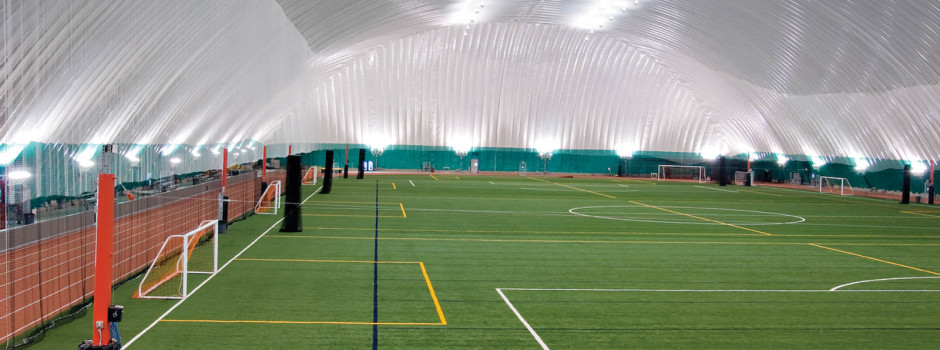What fabric manufacturers know about PVC fabrics that you should know, too.
Many businesses in the industrial fabrics industry (Seaman Corp. among them) have shown consistent growth over decades by developing cost-effective, high-performance products that utilize vinyl—a polymer used safely and successfully in a range of applications.
Today, the vinyl industry represents $54 billion of the U.S. economy, $5 billion of annual exports and employs more than 350,000 workers. The polyvinyl chloride polymer (vinyl, produced as a powder known as “vinyl resin”) is one of the most resource-efficient and sustainable plastic polymers ever discovered and developed.
Fifty percent of the primary feedstock for this polymer is salt, certainly in abundant supply in the United States. The other 50 percent is natural gas, also a domestic resource in abundant supply. This versatile polymer has a multitude of durable applications ranging from outdoor awnings to hospital medical applications. It can be easily recycled and repurposed, as much of it is done today.
Activism against vinyl
In recent years, well-organized and well-funded activist organizations have attempted to convince the public that vinyl is a hazardous plastic by promoting disparaging health and environmental claims and utilizing narratives not based in scientific fact. These claims fail to recognize how safely the industry has evolved.
Because of these arguments against vinyl, many consumer product manufacturers and environmental certifiers are adopting “PVC-free” positions, which are included in the advertising and environmental certification of these consumer products. Equally disturbing, organizations such as the U.S. Green Building Council (USGBC) are encouraging the de-selection of vinyl products. The USGBC in its new LEED v4 standard includes credits to encourage the de-selection of vinyl products through ingredient reporting and reformulation. This latter criteria means de-selecting such proven products as vinyl roofing, PVC piping, vinyl siding and vinyl-framed windows. Ultimately, vinyl awnings, fabric structures and other vinyl products could be targeted as well.
The USGBC promulgation of bad science on materials like PVC and other chemicals is shifting its focus from promoting energy- and water-efficient standards for building construction to becoming an activist health and safety policy advocate. Its anti-vinyl standards are not developed by a nationally recognized open consensus process, such as the American National Standards Institute (ANSI), and are in direct conflict with the USGBC’s own scientific task force study on the attributes of vinyl construction products.
In 2004, the USGBC commissioned its Technical and Scientific Advisory Committee (TSAC) to study the environmental impacts of four vinyl construction products: vinyl window frames, vinyl siding, PVC piping and vinyl resilient flooring. The biased subjectivity of this TSAC assignment is embodied in its stated mission: “To investigate whether for those applications the available evidence indicates that PVC-based materials are consistently among the worst of the materials studied in terms of environmental and health impacts.” After three years of study, the TSAC was unable to conclude that vinyl construction products were any worse than alternative materials. In fact, the study concluded that vinyl-framed windows are more energy efficient and sustainable when compared to alternatives such as wood or aluminum. The report specifically states that the USGBC should not incorporate a de-selection credit for vinyl products, and that, “The evidence indicates that a credit that rewards avoidance of PVC could steer decision makers toward using materials that are worse on most environment impacts.”
Nonetheless, continued communication of misrepresentations by organizations—such as the USGBC—influences public policy decisions, particularly federal and state governments. The 2010 building and construction guidance manual (GSA P-100) of the General Services Administration (GSA) (the primary landlord of the federal government) contains numerous conflicting references to vinyl products. Recently, a GSA procurement officer specifically excluded vinyl roofing in a five-year GSA contract because he believed a vinyl roof would be a health hazard. Similarly, a GSA subject matter expert recently said in a Los Angeles court house specification, “P-100 recommends that PVC be avoided where possible to avoid introducing toxins into the environment. … Please explain why PVC-containing materials are still specified by providing initial and life-cycle cost analysis.”
These types of actions require a strong response from the specialty fabrics industry to ensure that users of these documents are receiving accurate information.
Dated information
The claims of vinyl being a health and environmental hazard are based on issues that were identified in the 1960s and quickly addressed by the industry. When vinyl chloride monomer was found to be a worker health hazard, the vinyl resin industry developed ways to significantly reduce residual vinyl monomer with manufacturing processes that achieved more complete polymerization. Any remaining monomer was safely and effectively removed from the resin product before it was shipped. This virtually eliminated worker exposure.
The second major point made by organizations opposing vinyl use is that vinyl creates harmful dioxin in our atmosphere when it is burned. In reality there are many natural and manmade sources of dioxin. The vinyl industry has been a leader in reducing dioxin emissions; today only grams per year are produced by this industry that produces some 15 billion pounds of vinyl resin.
A 2006 EPA study found that dioxin emissions from all sources declined by 90 percent between 1987 and 2000, a time when the production of vinyl products continued to increase significantly. Dioxin emission from the chlorine industry has decreased another 75 percent since 2000. In fact, the greatest contributors to dioxin today are forest fires, firewood and backyard burning of leaves. The EPA study says, “Government regulatory actions along with voluntary industry actions have resulted in dramatic reductions in each of these [industrial] sources, and they are no longer major contributors of dioxins to the environment in the United States.”
Vinyl blood storage
One of the great ironies of PVC-opponent arguments is the use of vinyl in storing our blood supply. If vinyl is such a threat to our health and to the environment, why is our blood supply stored in flexible vinyl bags?
Furthermore, the blood is delivered into the human body through flexible vinyl tubing. Blood is preserved twice as long in flexible vinyl bags as in any other available storage material.
If we were unable to use vinyl bags, it seems plausible that it could seriously diminish the quantity of blood available at any given time.
Vinyl advocacy
The vinyl building products industry has been facing the challenges of unsubstantiated claims, presented by organizations such as the USGBC, that are detrimental to their business. As a result, the industry has recently established the Vinyl Building Council (VBC), a working group of the Vinyl Institute. Its purpose is to initiate and promote a public advocacy strategy to federal, state and local governments that accurately portrays the vinyl polymer’s health and safety record supported with scientific facts, and provide information concerning the significant economic impact the vinyl industry plays in our economy.
VBC has worked closely with a coalition of other interested building products organizations comprising the American High-Performance Building Coalition (AHPBC) in challenging the USGBC’s LEED v4 standard. Specifically, it has been urging government organizations such as the GSA and state governments to understand that the LEED v4 standard was not developed with nationally accepted scientific and consensus-based processes. VBC is urging federal, state and local governments to adopt alternative consensus-based energy savings codes for its building and construction projects. This is arduous work. The USGBC, a private nonprofit organization, generates in excess of $120 million a year by promoting its LEED standards and has a balance sheet that includes more than $80 million in cash.
VBC and AHPBC have recently been successful in getting the GSA to drop its exclusive adoption of LEED as a green building rating system and are now including the Green Globes standard developed by the Green Building Institute. The Green Globes standard has been developed with the ANSI open consensus standard. Equally as effective as LEED, it is much easier to implement at one third the cost of LEED. Furthermore, GSA did not adopt the more recent LEED v4 and its major chemical de-selection criteria, but endorsed the previous LEED 2009 standard.
While the recent GSA decision is illustrative of the importance and value of a public advocacy strategy, there is much more to be accomplished. It is important for all businesses in the vinyl value chain to become involved with this public policy advocacy effort. While anti-vinyl activist organizations may not be affecting all sectors of the vinyl industry today, it is a credible assumption that in time they could impact the public’s perception of the health and safety of anything manufactured from vinyl.
VBC is an important group working on this public advocacy effort. Most such efforts are spearheaded by large organizations such as the American Chemistry Council and its large chemical company members. VBC is comprised primarily of mid-sized and small businesses spread across the country. It represents a larger geographic area, a vastly larger number of jobs, and has more impact on individual legislative districts. This type of representation gets more attention from the legislators and government administrators when implementing a public policy initiative.
 TEXTILES.ORG
TEXTILES.ORG






